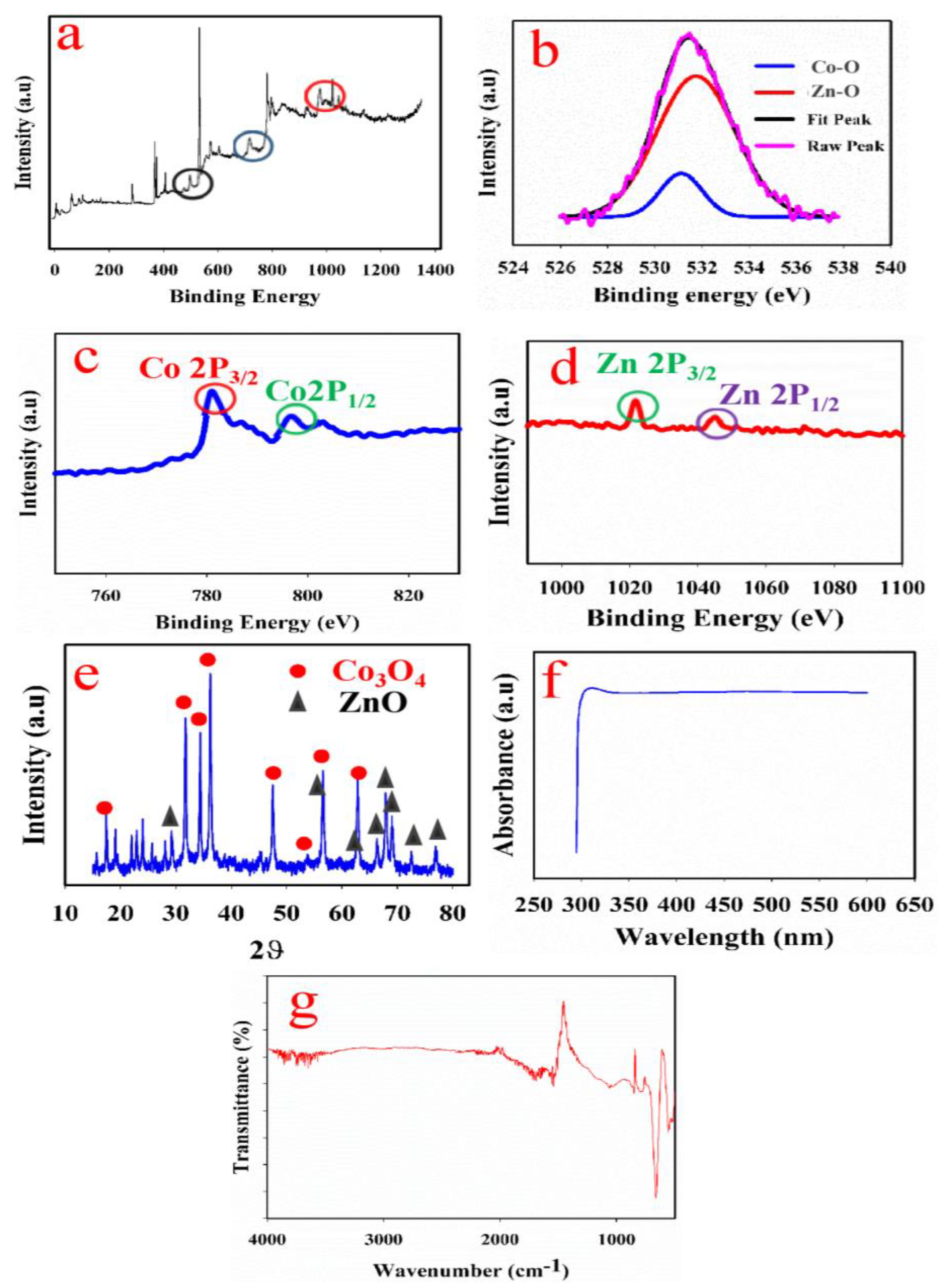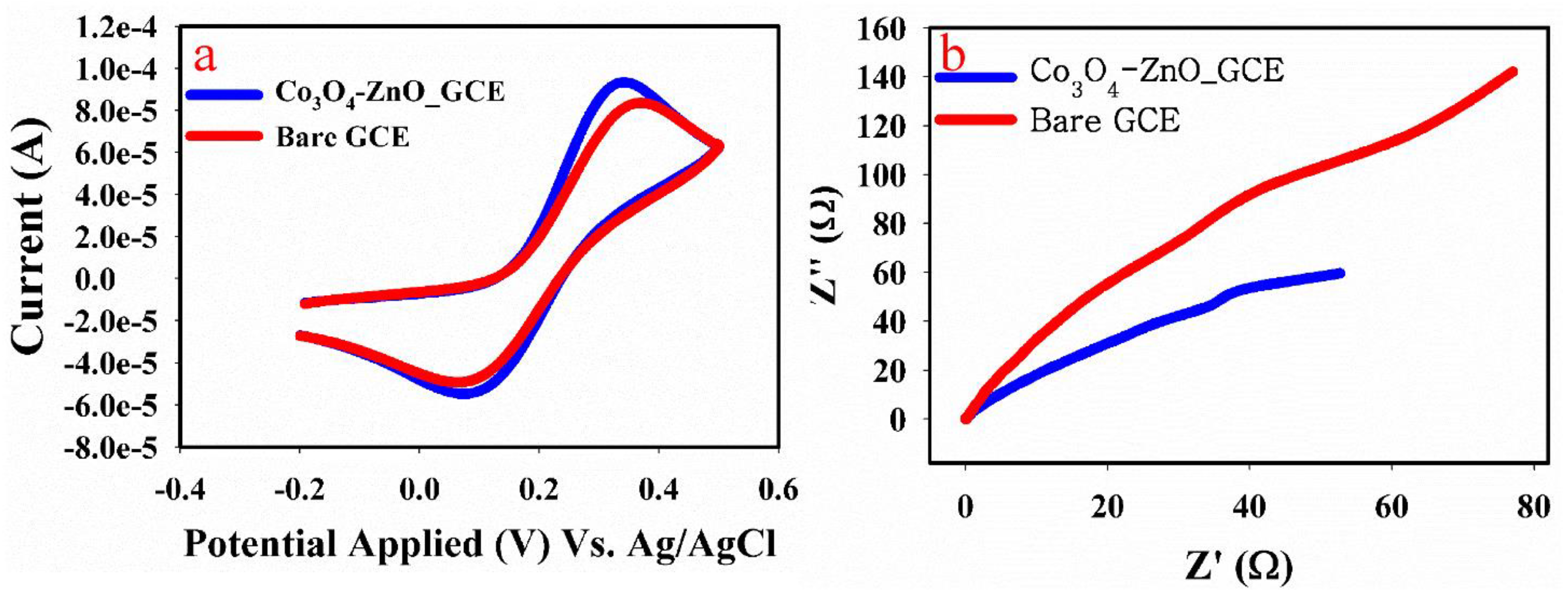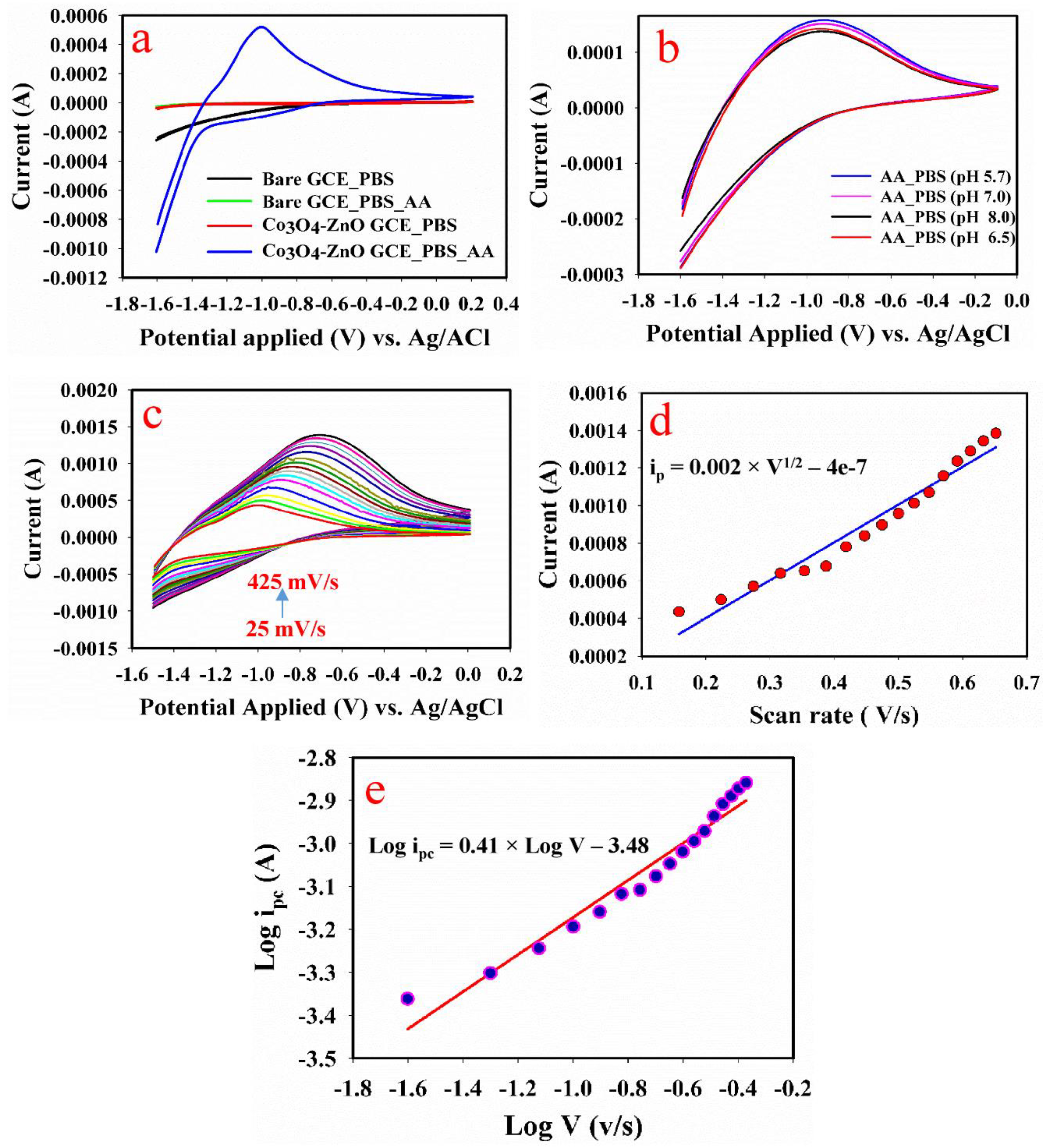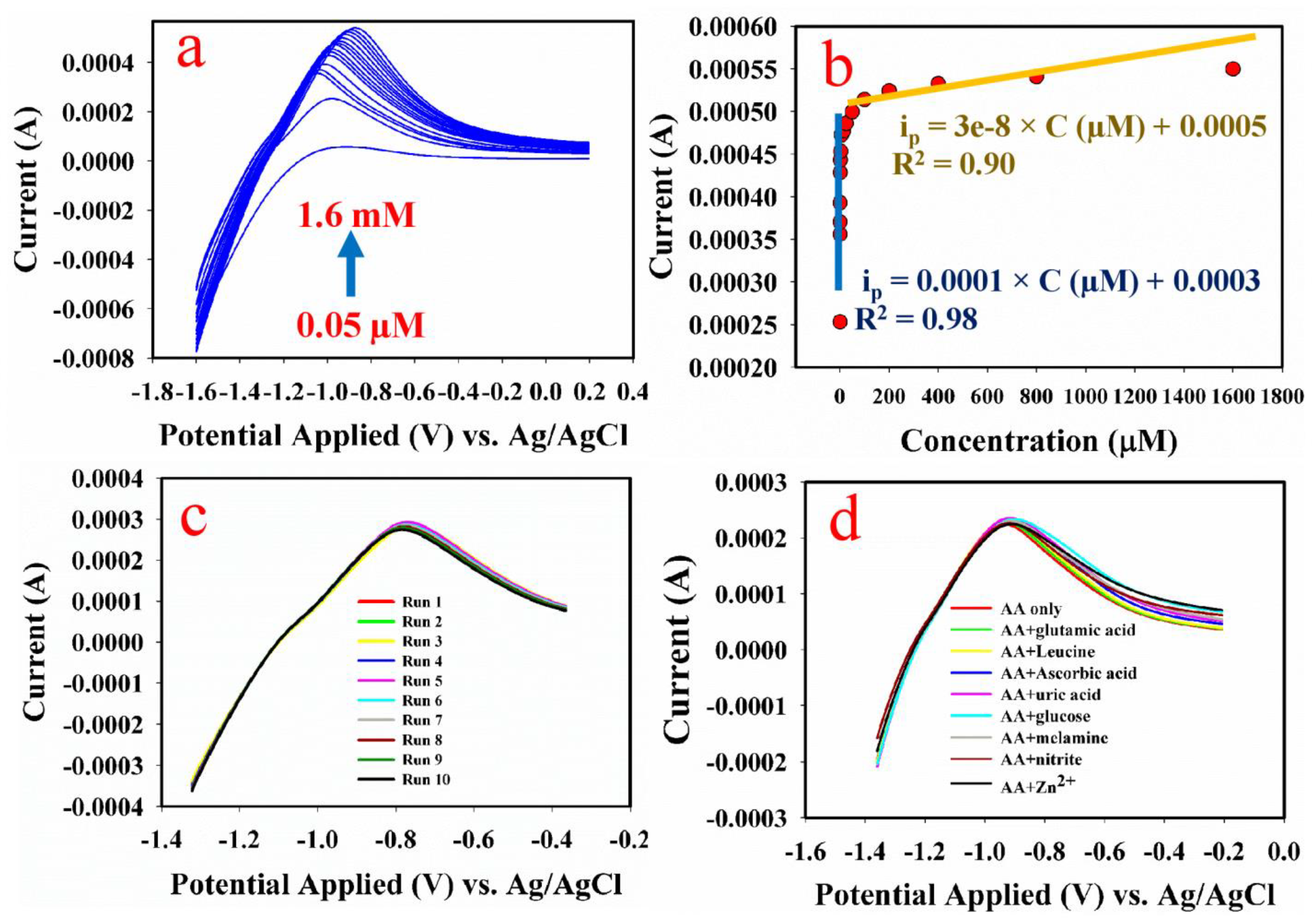Sensitive and Rapid Detection of Aspartic Acid with Co3O4-ZnO Nanorods Using Differential Pulse Voltammetry
Abstract
1. Introduction
2. Materials and Methods
2.1. Chemicals and Reagents
2.2. Apparatus
2.3. Synthesis of Co3O4-ZnO Nanorods
2.4. Fabrication of Co3O4-ZnO Nanorod Coated Electrode
2.5. Characterization Technique
2.6. Interference Studies
2.7. Real Sample Analysis
3. Results and Discussion
3.1. Synthesis of Co3O4-ZnO Nanorod
3.2. Structural and Morphological Studies
3.3. XEDS Analysis
3.4. XPS Analysis
3.5. XRD Analysis
3.6. Optical Analysis (UV-Vis and FTIR Analyses)
3.7. Electrochemical Characterization
3.7.1. Electron Mobility
3.7.2. Impedance Study
3.8. Sensing Application
3.8.1. Control Study
3.8.2. pH Variation
3.8.3. Scan Rate Effect
3.8.4. Calibration Plot
3.8.5. Analytical Performance
3.8.6. Sensor Stability
3.8.7. Real Sample Analysis
3.8.8. Comparability with Other Reported Methods
4. Conclusions
Supplementary Materials
Author Contributions
Funding
Institutional Review Board Statement
Informed Consent Statement
Data Availability Statement
Acknowledgments
Conflicts of Interest
References
- Tabaraki, R.; Abdi, O. Microwave Assisted Synthesis of N-Doped Carbon Dots: An Easy, Fast and Cheap Sensor for Determination of Aspartic Acid in Sport Supplements. J. Fluoresc. 2019, 29, 751–756. [Google Scholar] [CrossRef]
- Prasad, B.B.; Jaiswal, S.; Singh, K. Ultra-trace analysis of D-and L-aspartic acid applying one-by-one approach on a dual imprinted electrochemical sensor. Sens. Actuators B Chem. 2017, 240, 631–639. [Google Scholar] [CrossRef]
- Prasad, B.B.; Pandey, I. Electrochemically imprinted molecular recognition sites on multiwalled carbon-nanotubes/pencil graphite electrode surface for enantioselective detection of d- and l-aspartic acid. Electrochim. Acta 2013, 88, 24–34. [Google Scholar] [CrossRef]
- Van Den Oetelaar, P.J.M.; Van Beijsterveldt, L.E.C.; Van Beckhoven, J.R.C.M.; Hoenders, H.J. Detection of aspartic acid enantiomers by chiral capillary gas chromatography: Determination of in vivo racemization and reduction of metal-induced background. J. Chromatogr. A 1986, 368, 135–143. [Google Scholar] [CrossRef]
- Yu, H.; Ding, Y.-S.; Mou, S.-F. Some factors affecting separation and detection of amino acids by high-performance anion-exchange chromatography with integrated pulsed amperometric detection. J. Chromatogr. A 2003, 997, 145–153. [Google Scholar] [CrossRef]
- Wang, S.; Fan, L.; Cui, S. CE-LIF chiral separation of aspartic acid and glutamic acid enantiomers using human serum albumin and sodium cholate as dual selectors. J. Sep. Sci. 2009, 32, 3184–3190. [Google Scholar] [CrossRef]
- Safronova, E.; Parshina, A.; Kolganova, T.; Bobreshova, O.; Pourcelly, G.; Yaroslavtsev, A. Potentiometric sensors arrays based on perfluorinated membranes and silica nanoparticles with surface modified by proton-acceptor groups, for the determination of aspartic and glutamic amino acids anions and potassium cations. J. Electroanal. Chem. 2018, 816, 21–29. [Google Scholar] [CrossRef]
- Adeosun, W.A.; Asiri, A.M.; Marwani, H.M.; Rahman, M.M. Enzymeless Electrocatalytic Detection of Uric Acid Using Polydopamine/Polypyrrole Copolymeric film. ChemistrySelect 2020, 5, 156–164. [Google Scholar] [CrossRef]
- Asiri, A.M.; Adeosun, W.A.; Marwani, H.M. Electrocatalytic reduction of 2, 6-dinitrophenol on polycongo red decorated glassy carbon electrode for sensing application. J. Environ. Chem. Eng. 2020, 8, 104378. [Google Scholar] [CrossRef]
- Adeosun, W.A.; Asiri, A.M.; Marwani, H.M. Real time detection and monitoring of 2, 4-dinitrophenylhydrazine in industrial effluents and water bodies by electrochemical approach based on novel conductive polymeric composite. Ecotoxicol. Environ. Saf. 2020, 206, 111171. [Google Scholar] [CrossRef]
- Gao, J.; Lv, D.; Sun, H.; Yang, W. Determination of L-aspartic acid by using the Cu(II)-catalyzed oscillating reaction. J. Braz. Chem. Soc. 2009, 20, 1827–1832. [Google Scholar] [CrossRef]
- Fontanarosa, C.; Pane, F.; Sepe, N.; Pinto, G.; Trifuoggi, M.; Squillace, M.; Errico, F.; Usiello, A.; Pucci, P.; Amoresano, A. Quantitative determination of free D-Asp, LAsp and N-methyl-D-aspartate in mouse brain tissues by chiral separation and Multiple Reaction Monitoring tandem mass spectrometry. PLoS ONE 2017, 12, e0179748. [Google Scholar] [CrossRef] [PubMed]
- Singh, N.; Singh, P.K.; Singh, M.; Gangopadhyay, D.; Singh, S.K.; Tandon, P. Development of a potential LPG sensor based on a PANI–Co3O4 nanocomposite that functions at room temperature. New J. Chem. 2019, 43, 17340–17350. [Google Scholar] [CrossRef]
- Mini, V.; Archana, K.; Raghu, S.; Sharanappa, C.; Devendrappa, H. Nanostructured multifunctional core/shell ternary composite of polyaniline-chitosan-cobalt oxide: Preparation, electrical and optical properties. Mater. Chem. Phys. 2016, 170, 90–98. [Google Scholar] [CrossRef]
- Li, S.J.; Xing, Y.; Yang, H.Y.; Huang, J.Y.; Wang, W.T.; Liu, R.T. Electrochemical synthesis of a binary Mn-Co oxides decorated graphene nanocomposites for application in nonenzymatic H2O2 sensing. Int. J. Electrochem. Sci. 2017, 12, 6566–6576. [Google Scholar] [CrossRef]
- Sharma, R.K.; Ghose, R. Synthesis of Co3O4–ZnO mixed metal oxide nanoparticles by homogeneous precipitation method. J. Alloys Compd. 2016, 686, 64–73. [Google Scholar] [CrossRef]
- Alam, M.M.; Asiri, A.M.; Uddin, M.T.; Inamuddin; Islam, M.A.; Awual, M.R.; Rahman, M.M. One-step wet-chemical synthesis of ternary ZnO/CuO/Co3O4 nanoparticles for sensitive and selective melamine sensor development. New J. Chem. 2019, 43, 4849–4858. [Google Scholar] [CrossRef]
- Zhang, X.; Zhang, Y.C.; Ma, L.X. One-pot facile fabrication of graphene-zinc oxide composite and its enhanced sensitivity for simultaneous electrochemical detection of ascorbic acid, dopamine and uric acid. Sensors Actuators, B Chem. 2016, 227, 488–496. [Google Scholar] [CrossRef]
- Ebrahimiasl, S.; Zakaria, A.; Kassim, A.; Basri, S.N. Novel conductive polypyrrole/zinc oxide/chitosan bionanocomposite: Synthesis, characterization, antioxidant, and antibacterial activities. Int. J. Nanomed. 2014, 10, 217–227. [Google Scholar] [CrossRef]
- Yang, Y.; Wang, X.; Yi, G.; Li, H.; Shi, C.; Sun, G.; Zhang, Z. Hydrothermal synthesis of co3 o4/zno hybrid nanoparticles for triethylamine detection. Nanomaterials 2019, 9, 1599. [Google Scholar] [CrossRef]
- Tak, Y.; Yong, K. A Novel Heterostructure of Co3O4/ZnO Nanowire Array Fabricated by Photochemical Coating Method. J. Phys. Chem. C 2008, 112, 74–79. [Google Scholar] [CrossRef]
- Mohamed Reda, G.; Fan, H.; Tian, H. Room-temperature solid state synthesis of Co3O4/ZnO p–n heterostructure and its photocatalytic activity. Adv. Powder Technol. 2017, 28, 953–963. [Google Scholar] [CrossRef]
- Liu, Y.; Zhu, G.; Chen, J.; Xu, H.; Shen, X.; Yuan, A. Co 3 O 4 /ZnO nanocomposites for gas-sensing applications. Appl. Surf. Sci. 2013, 265, 379–384. [Google Scholar] [CrossRef]
- Xu, J.; Liu, S.; Liu, Y. Co3O4/ZnO nanoheterostructure derived from core–shell ZIF-8@ZIF-67 for supercapacitors. RSC Adv. 2016, 6, 52137–52142. [Google Scholar] [CrossRef]
- Adeosun, W.A.; Asiri, A.M.; Marwani, H.M. Sensitive determination of 2-nitrophenol using electrochemically deposited polymethyl red film for healthcare and environmental safety. Synth. Met. 2020, 261, 116321. [Google Scholar] [CrossRef]
- Rakibuddin, M.; Ananthakrishnan, R. Porous ZnO/Co3O4 heteronanostructures derived from nano coordination polymers for enhanced gas sorption and visible light photocatalytic applications. RSC Adv. 2015, 5, 68117–68127. [Google Scholar] [CrossRef]
- Tabassum, S.; Usman, M.; Al-Lohedan, H.A.; Abdullah, M.M.S.; Ghanem, M.A.; Al-Sharif, M.S.; Ali, M.S. Synthesis of homo- And hetero-metallic cobalt and zinc nano oxide particles by a calcination process using coordination compounds: Their characterization, DFT calculations and capacitance behavioural study. RSC Adv. 2020, 10, 13126–13138. [Google Scholar] [CrossRef]
- Prabaharan, D.D.M.; Sadaiyandi, K.; Mahendran, M.; Sagadevan, S. Precipitation method and characterization of cobalt oxide nanoparticles. Appl. Phys. A Mater. Sci. Process. 2017, 123, 264. [Google Scholar] [CrossRef]
- Hussain, M.M.; Rahman, M.M.; Asiri, A.M.; Awual, M.R. Non-enzymatic simultaneous detection of l-glutamic acid and uric acid using mesoporous Co3O4 nanosheets. RSC Adv. 2016, 6, 80511–80521. [Google Scholar] [CrossRef]
- Al-Senani, G.M.; Deraz, N.M.; Abd-Elkader, O.H. Magnetic and characterization studies of CoO/Co3O4 nanocomposite. Processes 2020, 8, 844. [Google Scholar] [CrossRef]
- Geetha, M.S.; Nagabhushana, H.; Shivananjaiah, H.N. Green mediated synthesis and characterization of ZnO nanoparticles using Euphorbia Jatropa latex as reducing agent. J. Sci. Adv. Mater. Devices 2016, 1, 301–310. [Google Scholar] [CrossRef]
- Estrada-Urbina, J.; Cruz-Alonso, A.; Santander-González, M.; Méndez-Albores, A.; Vázquez-Durán, A. Physiological and sanitary quality of a Mexican landrace of red maize. Nanomaterials 2018, 8, 247. [Google Scholar] [CrossRef] [PubMed]
- Cordeiro, T.A.R.; Gonçalves, M.V.C.; Franco, D.L.; Reis, A.B.; Martins, H.R.; Ferreira, L.F. Label-free electrochemical impedance immunosensor based on modified screen-printed gold electrodes for the diagnosis of canine visceral leishmaniasis. Talanta 2019, 195, 327–332. [Google Scholar] [CrossRef]
- Zhu, X.; Zhang, K.; Wang, D.; Zhang, D.; Yuan, X.; Qu, J. Electrochemical sensor based on hydroxylated carbon nanotubes/platinum nanoparticles/rhodamine B composite for simultaneous determination of 2,4,6-trichlorophenol and 4-chlorophenol. J. Electroanal. Chem. 2018, 810, 199–206. [Google Scholar] [CrossRef]
- Kuralay, F.; Dumangöz, M.; Tunç, S. Polymer/carbon nanotubes coated graphite surfaces for highly sensitive nitrite detection. Talanta 2015, 144, 1133–1138. [Google Scholar] [CrossRef]
- Ahmed, J.; Rakib, R.H.; Rahman, M.M.; Asiri, A.M.; Siddiquey, I.A.; Islam, S.S.M.; Hasnat, M.A. Electrocatalytic Oxidation of 4-Aminophenol Molecules at the Surface of an FeS2/Carbon Nanotube Modified Glassy Carbon Electrode in Aqueous Medium. Chempluschem 2019, 84, 175–182. [Google Scholar] [CrossRef] [PubMed]
- Adeosun, W.; Asiri, A.M.; Marwani, H.M. Fabrication of conductive polypyrole doped chitosan thin film for sensitive detection of sulfite in real food and biological samples. Electroanalysis 2020, 32, 1725–1736. [Google Scholar] [CrossRef]
- Rahman, M.M.; Adeosun, W.A.; Asiri, A.M. Fabrication of Flower-Flake La2ZnO4 Nanocomposite for Effective Non-Enzymatic Sensing of Hydrogen Peroxide. Microchem. J. 2020, 159, 105536. [Google Scholar] [CrossRef]
- Soleimani-Lashkenari, M.; Rezaei, S.; Fallah, J.; Rostami, H. Electrocatalytic performance of Pd/PANI/TiO2 nanocomposites for methanol electrooxidation in alkaline media. Synth. Met. 2018, 235, 71–79. [Google Scholar] [CrossRef]
- Karimi-Maleh, H.; Arotiba, O.A. Simultaneous determination of cholesterol, ascorbic acid and uric acid as three essential biological compounds at a carbon paste electrode modified with copper oxide decorated reduced graphene oxide nanocomposite and ionic liquid. J. Colloid Interface Sci. 2020, 560, 208–212. [Google Scholar] [CrossRef]
- Asiri, A.M.; Adeosun, W.A.; Marwani, H.M.; Rahman, M.M. Homopolymerization of 3-aminobenzoic acid for enzyme-free electrocatalytic assay of nitrite ions. New J. Chem. 2020, 44, 2022–2032. [Google Scholar] [CrossRef]
- Goseer, D.K. Cyclic Voltametry-Simulation and Analysis of Reaction; VCH: New York, NY, USA, 1993; ISBN 3-527-28226-2. [Google Scholar]
- Bard, G.A.; Inzelt, F.S. Electrochemistry Dictionary; Springer: Berlin/Heidelberg, Germany, 2008. [Google Scholar]
- Bard, A.J.; Faulkner, L.R. Electrochemical Methods: Fundamentals and Applications, 2nd ed.; Wiley: New York, NY, USA, 2001. [Google Scholar]
- Asiri, A.M.; Adeosun, W.A.; Rahman, M.M. Development of highly efficient non-enzymatic nitrite sensor using La2CuO4 nanoparticles. Microchem. J. 2020, 159, 105527. [Google Scholar] [CrossRef]
- Zhang, Y.; Cao, J.; Ding, L. Fluorescent ensemble based on dansyl derivative/SDS assemblies as selective sensor for Asp and Glu in aqueous solution. J. Photochem. Photobiol. A Chem. 2017, 333, 56–62. [Google Scholar] [CrossRef]
- Weng, H.; Yan, B. A sliver ion fabricated lanthanide complex as a luminescent sensor for aspartic acid. Sens. Actuators B Chem. 2017, 253, 1006–1011. [Google Scholar] [CrossRef]
- Wu, P.; Jiang, M.; Hu, X.; Wang, J.; He, G.; Shi, Y.; Li, Y.; Liu, W.; Wang, J. Amide-containing luminescent metal–organic complexes as bifunctional materials for selective sensing of amino acids and reaction prompting. RSC Adv. 2016, 6, 27944–27951. [Google Scholar] [CrossRef]
- Zhao, X.; Wei, R.; Chen, L.; Jin, D.; Yan, X. Glucosamine modified near-infrared cyanine as a sensitive colorimetric fluorescent chemosensor for aspartic and glutamic acid and its applications. New J. Chem. 2014, 38, 4791–4798. [Google Scholar] [CrossRef]
- Das, S.; Guha, S.; Banerjee, A.; Lohar, S.; Sahana, A.; Das, D. 2-(2-Pyridyl) benzimidazole based Co(ii) complex as an efficient fluorescent probe for trace level determination of aspartic and glutamic acid in aqueous solution: A displacement approach. Org. Biomol. Chem. 2011, 9, 7097–7104. [Google Scholar] [CrossRef]
- Ranjani, M.; Kalaivani, P.; Dallemer, F.; Selvakumar, S.; Kalpana, T.; Prabhakaran, R. Fluorescent Cu(II) complex as chemosensor for the detection of l-Aspartic acid with high selectivity and sensitivity. Inorg. Chim. Acta 2022, 530, 120683. [Google Scholar] [CrossRef]
- Alam, M.M.; Asiri, A.M.; Hasnat, M.A.; Rahman, M.M. Detection of L-Aspartic Acid with Ag-Doped ZnO Nanosheets Using Differential Pulse Voltammetry. Biosensors 2022, 12, 379. [Google Scholar] [CrossRef]
- Wei, X.; Chen, Y.; He, S.; Lian, H.; Cao, X.; Liu, B. Bovine serum albumin-coated titanium dioxide modified electrochemical interface for enantioselective discrimination of D/L-aspartic acid. Chirality 2021, 33, 731–744. [Google Scholar] [CrossRef]





| Sample Type | N/A | Spiked (µM) | Found (µM) | RSD (%) | Bias | Recovery (%) |
|---|---|---|---|---|---|---|
| Beverage drink | 3 | 0 µM | N.D | N.D | - | N.D |
| 3 | 50 µM | 47.2 ± 1.48 | 3.14 | −2.8 | 94.4 | |
| Mouse serum | 3 | 0 µM | N.D | N.D | N.D | N.D |
| 3 | 50 µM | 43.8 ± 1.73 | 3.95 | −6.2 | 87.6 |
| Sensing Matrix | Method | LOD (µM) | # LR (µM) | Ref. |
|---|---|---|---|---|
| Dansyl derivative/SDS | Fluorescence | 0.60 | 0.04–0.8mM | [46] |
| Lanthanide complex | Fluorescence | 0.46 | 0.1–1000 | [47] |
| Bifunctional materials | Fluorescence | 0.26 | 0.1–133 | [48] |
| N-Doped carbon | Fluorescence | 0.09 | 0.5–50 | [1] |
| Glucosamine-cyanine probe | Fluorescence | - | 0.1–10 | [49] |
| 2-(2-pyridyl) benzimidazole | Fluorescence | 10 | 10–300 | [50] |
| Flurescent Cu (II) ion | Fluorescence | 0.084 | 1–10 | [51] |
| Ag2O/ZnO | Electrochemical | 3.5 | 15–105 | [52] |
| Polymer/MWCNTs | Electrochemical | 4.08 ng/mL | 3.89–66.23 | [2] |
| Bolvin-serum/TiO2/GCE | Electrochemical | 0.009 | - | [53] |
| Co3O4-ZnO/GCE | Electrochemical | 0.03 | 0.05–50 | Current study |
Disclaimer/Publisher’s Note: The statements, opinions and data contained in all publications are solely those of the individual author(s) and contributor(s) and not of MDPI and/or the editor(s). MDPI and/or the editor(s) disclaim responsibility for any injury to people or property resulting from any ideas, methods, instructions or products referred to in the content. |
© 2023 by the authors. Licensee MDPI, Basel, Switzerland. This article is an open access article distributed under the terms and conditions of the Creative Commons Attribution (CC BY) license (https://creativecommons.org/licenses/by/4.0/).
Share and Cite
Alfaifi, S.Y.; Adeosun, W.A.; Asiri, A.M.; Rahman, M.M. Sensitive and Rapid Detection of Aspartic Acid with Co3O4-ZnO Nanorods Using Differential Pulse Voltammetry. Biosensors 2023, 13, 88. https://doi.org/10.3390/bios13010088
Alfaifi SY, Adeosun WA, Asiri AM, Rahman MM. Sensitive and Rapid Detection of Aspartic Acid with Co3O4-ZnO Nanorods Using Differential Pulse Voltammetry. Biosensors. 2023; 13(1):88. https://doi.org/10.3390/bios13010088
Chicago/Turabian StyleAlfaifi, Sulaiman Y., Waheed Abiodun Adeosun, Abdullah M. Asiri, and Mohammed M. Rahman. 2023. "Sensitive and Rapid Detection of Aspartic Acid with Co3O4-ZnO Nanorods Using Differential Pulse Voltammetry" Biosensors 13, no. 1: 88. https://doi.org/10.3390/bios13010088
APA StyleAlfaifi, S. Y., Adeosun, W. A., Asiri, A. M., & Rahman, M. M. (2023). Sensitive and Rapid Detection of Aspartic Acid with Co3O4-ZnO Nanorods Using Differential Pulse Voltammetry. Biosensors, 13(1), 88. https://doi.org/10.3390/bios13010088







